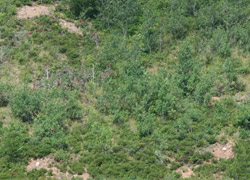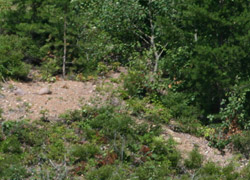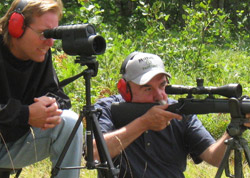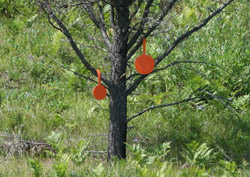Shooting Tips
A Simple Precision Shooting Range
Mastering your rifle requires shooting farther than 100 yards. Firing at greater, more challenging distances helps you learn your round's trajectory and diagnose problems that aren't very apparent at close range -- tiny errors in breathing, trigger control and sight picture become magnified with distance. Plus, wind isn't much of a factor at 100 yards, but estimating and compensating for wind can be important at 300 yards or more.
Unfortunately, however, very few public ranges offer firing at more than 100 yards. What's a precision shooter to do?
Wrestling with that problem a few years ago, I found a handy substitute which easily converts any suitable open area to a very usable long-distance shooting range.
 The cleared areas on this hillside contain ordinary rocks and pebbles as targets. Any nearby bullet impact is visible to the spotter.
The cleared areas on this hillside contain ordinary rocks and pebbles as targets. Any nearby bullet impact is visible to the spotter.A Suitable Site
The first requirement is that your improvised range have a suitable backstop -- that is, an earthen bank or hill or ridge into which your rounds can safely impact. The higher the backstop, the better, so even ricochets are stopped. With that in mind, recon public forest land or perhaps the land of a friendly farmer, who, like you, would appreciate having a place to shoot long-range.
Of course, your candidate site also must have some firing lanes -- either natural or enhanced by pruning and cutting -- so that you can shoot a considerable distance into that backstop. My preference is to shoot at least 500 yards.
The problem with a normal long-distance shooting range is that targets are so far away that your spotter cannot see where your bullet impacts, even with a quality spotting scope. Usually this means either you must put half your shooters in a target pit, lowering and marking targets for the rest of you -- which cuts shooting time in half -- or you must walk hundreds of yards to observe and then paste your bullet holes -- again, losing shooting time.
The solution, I found, was by how you prepared this range.
 Viewed through a telephoto lens at 500 yards, these two cleared areas offer a variety of targets measuring 3 inches to 8 inches.
Viewed through a telephoto lens at 500 yards, these two cleared areas offer a variety of targets measuring 3 inches to 8 inches.Rocks and Cleared Earth
Having found a location with a suitable backstop and firing lanes on which you can shoot at least 500 yards, select a half-dozen target locations along the backstop. At each target location clear away one square yard, right down to bare earth. In this cleared ground, place contrasting pebbles and rocks -- as small as 3 inches, as large as 8 inches.
These pebbles and rocks are your targets, with the size (and shooting distance) creating the level of difficulty. To start with, a shooter can go for the 8-inch rocks (the size of an elk's vitals), and as he progresses take on the smaller, more challenging pebbles. The great thing about this arrangement is that -- unlike paper targets -- the exposed earth around the rocks allows a spotter to see exactly where his shooter's every shot impacts.
This is a tremendous benefit, instantly reporting those misses, which is at least as important as recording your hits. Not only are you practice firing, but you're also confirming the exact target knob and bullet drop compensator settings for your cartridge. This also gives the spotter experience at observing bullet impacts and talking his shooter into a target when he misses, and all in a natural, field setting.
My precision range offers shooting from 50 yards to a maximum of 725 yards, and an unlimited number of firing positions because it's fairly open and grassy. I fire it as a two-man team with a fellow rifleman, and we rotate duties as spotter and shooter. From each firing position, we laze the target to learn its range, then the shooter uses a tripod support to fire. Engaging a specific pebble or rock, the shooter fires until he hits it -- records his elevation data -- then swaps roles with his spotter. On my latest shooting session we used Bushnell's new Excursion spotting scope, which contains a mil dot reticle. This allowed my spotter to talk me into targets or adjust my fire using mil measurements -- all I had to do was look through the mil reticle in my riflescope to see exactly what he meant. It worked pretty slick.
After my spotter and I hit the selected target from one firing position, we went to another and eventually maxed out at 725 yards. Usually I fire with an experienced long-range shooter or police SWAT sniper, but I've also used this range to help deer hunters practice holdovers in which they hold high to compensate for their bullet's drop. Hunters come away from this practice with the confidence that they can hit big game out to 400 yards.
 Teamed up with Major Plaster, this spotter uses Bushnell's new Excursion spotting scope, which contains a mil-dot reticle, to precisely adjust his fire.
Teamed up with Major Plaster, this spotter uses Bushnell's new Excursion spotting scope, which contains a mil-dot reticle, to precisely adjust his fire.Alternative Precision Targets
A variation on this setup is the employment of silicone, self-sealing targets, to create an instant precision shooting range. These targets, made by Newbold, use an elastic polymer that's about as resilient as soft rubber and can take thousands of hits before they need to be replaced.
A suitable backstop is again your first consideration, and then a few tree branches (or simple target stands) on which to attach the targets, which measure from 2 inches in diameter to 8 inches. They're available in orange, red, yellow and black.
Looking like a ping-pong paddle, the plastic target flips a bit when a bullet hits it, so your spotter can see the impact. In my experience you really need a .30 caliber or larger round to insure this "flip" because .223 rounds lack the mass to move it consistently.
The upside is that unlike steel reactive targets these soft targets generate no ricochets. The downside is that, unless these polymer targets are positioned before bare earth, a spotter will not be able to see the impact of misses.
Whether you fire at these polymer targets or ordinary pebbles, you'll find this improvised precision shooting range a real challenge and as fun as a shooting gallery with little or no cost. Just insure you have a proper backstop.
 Self-sealing targets, too, can convert a field setting into a precision shooting range.
Self-sealing targets, too, can convert a field setting into a precision shooting range.